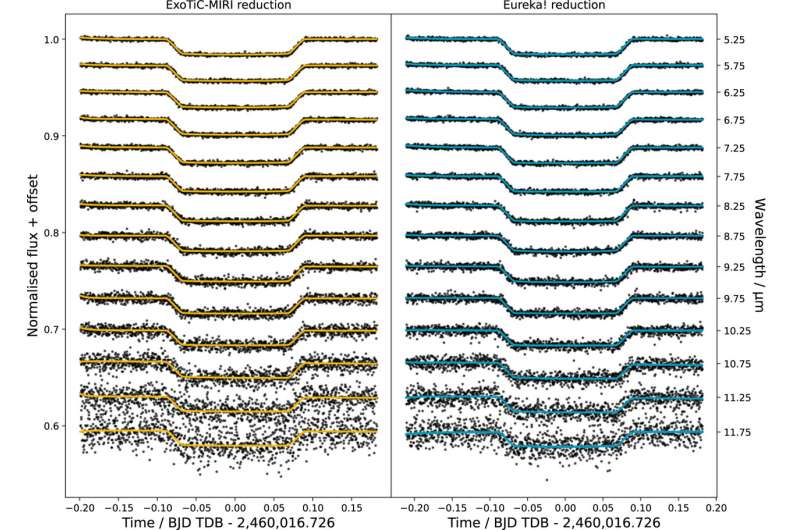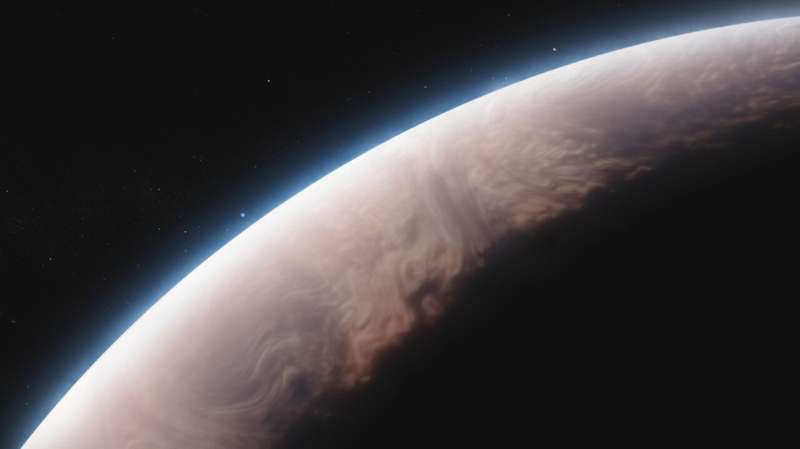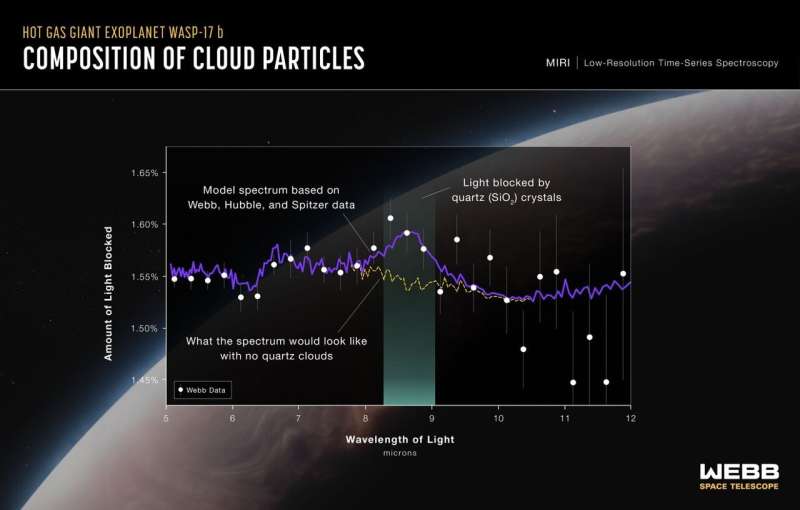This article has been reviewed according to Science X's editorial process and policies. Editors have highlighted the following attributes while ensuring the content's credibility:
fact-checked
peer-reviewed publication
trusted source
proofread
Webb detects quartz crystals in clouds of hot gas giant

Researchers using NASA's James Webb Space Telescope have detected evidence for quartz nanocrystals in the high-altitude clouds of WASP-17 b, a hot Jupiter exoplanet 1,300 light-years from Earth.
The detection, which was uniquely possible with MIRI (Webb's Mid-Infrared Instrument), marks the first time that silica (SiO2) particles have been spotted in an exoplanet atmosphere.
The quartz crystals are only about 10 nanometers across, so small that 10,000 could fit side-by-side across a human hair. Their size and composition of pure silica were reported in "JWST-TST DREAMS: Quartz Clouds in the Atmosphere of WASP-17b," published in Astrophysical Journal Letters.
"Hubble data actually played a key role in constraining the size of these particles. We know there is silica from Webb's MIRI data alone, but we needed the visible and near-infrared observations from Hubble for context, to figure out how large the crystals are," said co-author Nikole Lewis, associate professor of astronomy in the College of Arts and Sciences, member of the Carl Sagan Institute and leader of the Webb Guaranteed Time Observation (GTO) program designed to help build a three-dimensional view of a hot Jupiter atmosphere.
Webb observed the WASP-17 system for nearly 10 hours, collecting more than 1,275 brightness measurements of 5- to 12-micron mid-infrared light as the planet crossed its star. By subtracting the brightness of individual wavelengths of light that reached the telescope when the planet was in front of the star from those of the star on its own, the research team was able to calculate the amount of each wavelength blocked by the planet's atmosphere.

What emerged was an unexpected "bump" at 8.6 microns that was best explained by the clouds being composed of quartz, rather than magnesium silicates or other possible high-temperature aerosols like aluminum oxide.
Webb's unique ability to measure the extremely subtle effects of those crystals on starlight—and from a distance of more than 7 million billion miles—is providing critical information about the composition of exoplanet atmospheres and new insights into their weather.
The results from the paper's authors, who are part of the JWST Telescope Scientist Team and include researchers from NASA's Ames Research Center and NASA's Goddard Space Flight Center, puts a new spin on our understanding of how exoplanet clouds form and evolve. Rather than magnesium-rich silicates like olivine and pyroxene seen on other exoplanets, the researchers found their building blocks, the pure silica needed to form the larger silicate grains found in brown dwarfs and cooler exoplanets.
With a volume more than seven times that of Jupiter and a mass less than one-half of Jupiter, WASP-17 b is one of the largest and "puffiest" known exoplanets. This, along with its short orbital period of 3.7 Earth-days, makes the planet ideal for transmission spectroscopy: a technique that involves measuring the filtering and scattering effects of a planet's atmosphere on starlight to detect characteristics of its composition.
Unlike mineral particles found in clouds on Earth, the quartz crystals detected in the clouds of WASP-17 b are not swept up from a rocky surface. Instead, they originate in the atmosphere itself.

"WASP-17 b is extremely hot—around 2,700 degrees Fahrenheit—and the pressure where the quartz crystals form high in the atmosphere is only about one-thousandth of what we experience on Earth's surface. In these conditions, solid crystals can form directly from gas, without going through a liquid phase first," said first author David Grant, University of Bristol.
"Exactly how much quartz there is, and how pervasive the clouds, are tough to determine, but the team aims to do just that by combining these observations of WASP-17b with other observations of the system from JWST," Lewis said.
WASP-17 b is one of three planets targeted by the JWST Telescope Scientist Team's Deep Reconnaissance of Exoplanet Atmospheres using Multi-instrument Spectroscopy (DREAMS) investigations, which are designed to gather a comprehensive set of observations of one representative from each key class of exoplanets: a hot Jupiter, a warm Neptune, and a temperate rocky planet.
The MIRI observations of hot Jupiter WASP-17 b were made as part of GTO program 1353.
More information: David Grant et al, JWST-TST DREAMS: Quartz Clouds in the Atmosphere of WASP-17b, The Astrophysical Journal Letters (2023). DOI: 10.3847/2041-8213/acfc3b
Journal information: Astrophysical Journal Letters
Provided by Cornell University





















